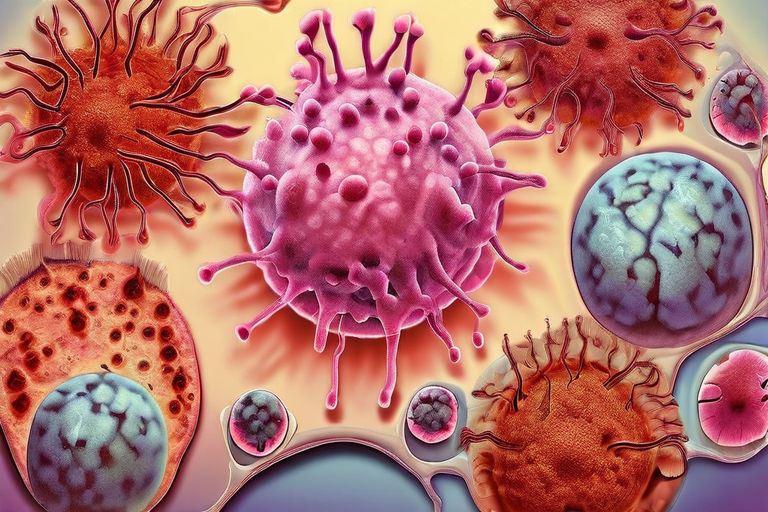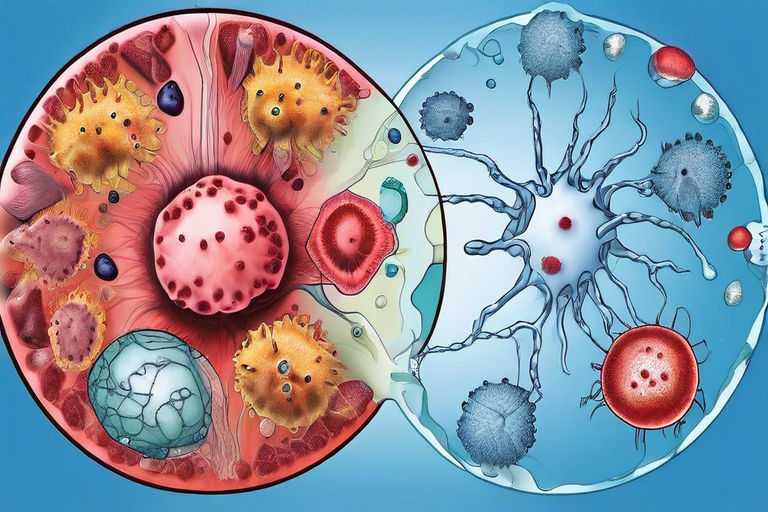Introduction
In the realm of biology, cells are the fundamental units of life. These microscopic structures come in two primary forms: prokaryotic and eukaryotic. Despite their similar-sounding names, they possess striking differences in structure, function, and complexity.
Certainly, here’s the revised section:
What Are Cells?
Cells are the fundamental units of life, serving as the building blocks of all living organisms. They are highly organized structures with specific functions crucial for the sustenance of life processes.
Defining Prokaryotic and Eukaryotic Cells
Prokaryotic cells and eukaryotic cells are the two main types of cells that form the basis of all living organisms. These cells differ significantly in their structure and organization, leading to variations in their functions and capabilities.
Significance of Cell Structure
The structure of a cell plays a vital role in determining its function and behavior. The intricate organization of cellular components within prokaryotic and eukaryotic cells dictates how they interact with their environment and carry out essential biological processes. Understanding the significance of cell structure is crucial for comprehending the complexities of life at the cellular level.
Structural Variances
Prokaryotic Cells
Prokaryotic cells are characterized by their simple and primitive structure compared to eukaryotic cells. Unlike eukaryotic cells, prokaryotic cells lack a defined nucleus, which means that their genetic material floats freely in the cytoplasm.
Simplified Structure
The structure of prokaryotic cells is relatively uncomplicated, consisting of a cell membrane, cytoplasm, and a cell wall in some cases. They lack membrane-bound organelles such as mitochondria, endoplasmic reticulum, and Golgi apparatus, which are characteristic of eukaryotic cells.
Absence of Nucleus
One of the most distinctive features of prokaryotic cells is the absence of a true nucleus. Instead, their genetic material, typically in the form of a single, circular DNA molecule, is located in the nucleoid region within the cytoplasm.
Presence of Circular DNA
Prokaryotic cells contain a single circular chromosome that carries the genetic information necessary for their survival and replication. This circular DNA molecule is not enclosed within a membrane-bound nucleus, as seen in eukaryotic cells.
Prokaryotic Ribosomes
Ribosomes in prokaryotic cells are smaller and structurally different from those found in eukaryotic cells. These ribosomes play a crucial role in protein synthesis by translating the genetic code into proteins.
Eukaryotic Cells
Eukaryotic cells are distinguished by their complex and compartmentalized structure, which allows for specialized functions to be carried out within distinct organelles. Unlike prokaryotic cells, eukaryotic cells possess a true nucleus, where their genetic material is enclosed within a membrane-bound organelle.
Compartmentalized Structure
One of the defining features of eukaryotic cells is their compartmentalized structure. They contain membrane-bound organelles such as the nucleus, mitochondria, endoplasmic reticulum, Golgi apparatus, and lysosomes, each with specific roles in cellular processes.
Nucleus and Organelles
The nucleus of eukaryotic cells houses the cell’s genetic material, organized into linear chromosomes. This membrane-bound organelle serves as the control center of the cell, regulating gene expression and DNA replication.
Linear DNA in Chromosomes
Eukaryotic cells contain multiple linear chromosomes composed of DNA and associated proteins, known as histones. These chromosomes carry the genetic information required for the cell’s growth, development, and reproduction.
Eukaryotic Ribosomes
Ribosomes in eukaryotic cells are larger and more structurally complex than those found in prokaryotic cells. They exist in two forms: free ribosomes suspended in the cytoplasm and bound ribosomes attached to the endoplasmic reticulum. Eukaryotic ribosomes play a central role in protein synthesis by translating mRNA into proteins.
Functional Distinctions
Prokaryotic Cell Functions
Prokaryotic cells exhibit distinct functions that enable them to sustain life in various environments.
Metabolism and Energy Production
Prokaryotic cells are highly adaptable to diverse metabolic pathways, allowing them to thrive in a wide range of environments. They obtain energy through processes such as photosynthesis, fermentation, and aerobic respiration, depending on the availability of oxygen and other resources.
Reproduction
Prokaryotic cells reproduce primarily through a process called binary fission, where the cell divides into two identical daughter cells. This rapid and efficient method of reproduction allows prokaryotic populations to multiply rapidly under favorable conditions.
Adaptability
Prokaryotic cells possess remarkable adaptability, allowing them to survive and thrive in extreme environments such as hot springs, acidic lakes, and deep-sea hydrothermal vents. They can quickly adjust their metabolic processes and cellular structures in response to changes in their surroundings, ensuring their survival in challenging conditions.
These functional characteristics contribute to the ecological success of prokaryotic organisms and their widespread distribution across diverse habitats on Earth.
Eukaryotic Cell Functions
Eukaryotic cells are equipped with a wide array of functions facilitated by their complex internal organization and specialized organelles.
Specialized Functions of Organelles
Eukaryotic cells harbor a variety of membrane-bound organelles, each with specific functions crucial for cell survival and homeostasis. For instance, the mitochondria are responsible for energy production through cellular respiration, while the endoplasmic reticulum plays a key role in protein synthesis and lipid metabolism. Other organelles, such as the Golgi apparatus, lysosomes, and peroxisomes, contribute to various cellular processes, including protein modification, waste removal, and detoxification.
Complex Metabolic Processes
Eukaryotic cells engage in intricate metabolic processes to maintain cellular function and respond to environmental stimuli. These processes involve the coordinated action of enzymes and biochemical pathways within specialized organelles. Metabolic activities such as glycolysis, the citric acid cycle, and oxidative phosphorylation occur in different cellular compartments and are essential for energy production, biosynthesis, and cellular regulation.
Cell Communication
Eukaryotic cells employ sophisticated mechanisms for intercellular communication, allowing them to coordinate complex physiological processes and respond to external signals. Cell signaling pathways involve the transmission of chemical signals, such as hormones or neurotransmitters, between cells via specialized molecules and receptors. This communication network regulates various cellular functions, including growth, differentiation, and immune response, ensuring the proper functioning of multicellular organisms.
The intricate interplay of organelles, metabolic pathways, and signaling mechanisms in eukaryotic cells enables them to carry out diverse functions essential for life and maintain homeostasis in dynamic environments.
Evolutionary Origins
Prokaryotic Cells
Prokaryotic cells play a pivotal role in the early stages of life on Earth and have significantly influenced the course of evolutionary history.
Early Forms of Life
Prokaryotic cells are among the earliest forms of life to emerge on Earth, appearing approximately 3.5 to 4 billion years ago. These single-celled organisms were well-suited to the primitive conditions of the early Earth, thriving in environments rich in water, minerals, and organic compounds.
Role in Evolutionary History
Prokaryotic cells played a crucial role in shaping the Earth’s atmosphere and environment through processes such as photosynthesis and nitrogen fixation. Cyanobacteria, for example, were instrumental in oxygenating the atmosphere, paving the way for the evolution of aerobic organisms.
The evolutionary success of prokaryotic cells laid the foundation for the development of more complex life forms, including eukaryotic cells. The endosymbiotic theory suggests that eukaryotic cells arose through the symbiotic association of prokaryotic organisms, such as mitochondria and chloroplasts, with ancestral eukaryotic cells.
Prokaryotic cells continue to thrive in diverse environments today, demonstrating their remarkable adaptability and evolutionary resilience. Their evolutionary significance extends beyond their role as simple organisms, influencing the trajectory of life on Earth and contributing to the biodiversity of the planet.
Eukaryotic Cells
Eukaryotic cells, which are more complex than prokaryotic cells, are believed to have evolved through a process known as endosymbiosis.
Endosymbiotic Theory
The endosymbiotic theory proposes that eukaryotic cells originated from the symbiotic relationship between primitive prokaryotic cells. According to this theory, ancestral eukaryotic cells engulfed free-living bacteria-like organisms, forming a symbiotic association.
Origin of Organelles
Organelles such as mitochondria and chloroplasts, which are vital components of eukaryotic cells, are thought to have originated from these endosymbiotic events. Mitochondria, the “powerhouses” of the cell responsible for energy production, are believed to have evolved from aerobic bacteria. Similarly, chloroplasts, the organelles responsible for photosynthesis in plant cells, are thought to have evolved from photosynthetic bacteria.
Over time, these endosymbiotic relationships became mutually beneficial, with the host cell providing protection and resources to the endosymbiont in exchange for essential metabolic functions. Eventually, the endosymbionts became integrated into the host cell’s genome, leading to the development of eukaryotic cells with specialized organelles.
The endosymbiotic theory provides a compelling explanation for the origin of eukaryotic cells and their complex internal structure. It underscores the interconnectedness of life on Earth and the role of symbiosis in driving evolutionary innovation.
Comparative Analysis
Size and Complexity
When comparing prokaryotic and eukaryotic cells, differences in size and complexity are readily apparent.
Prokaryotic Cells
Prokaryotic cells are generally smaller and simpler in structure compared to eukaryotic cells. They typically range in size from 0.1 to 5 micrometers in diameter and have a relatively simple internal organization. Prokaryotic cells lack membrane-bound organelles and a distinct nucleus, with their genetic material located in a nucleoid region within the cytoplasm. Despite their small size, prokaryotic cells are highly efficient and adaptable, capable of carrying out essential life processes such as metabolism, reproduction, and adaptation to diverse environments.
Eukaryotic Cells
Eukaryotic cells, on the other hand, are larger and more complex than prokaryotic cells. They range in size from 10 to 100 micrometers in diameter and possess a variety of membrane-bound organelles, including a nucleus, mitochondria, endoplasmic reticulum, Golgi apparatus, and lysosomes. Eukaryotic cells exhibit compartmentalization, with distinct organelles performing specialized functions essential for cellular processes such as energy production, protein synthesis, and waste management. The presence of a true nucleus, which houses the cell’s genetic material, is a defining feature of eukaryotic cells.
Adaptability
Prokaryotic Cells
Prokaryotic cells are renowned for their remarkable adaptability to diverse environmental conditions. Their small size and simple structure allow them to thrive in a wide range of habitats, from extreme environments such as hot springs, acidic lakes, and deep-sea vents to more moderate conditions like soil, water, and even inside other organisms.
One key factor contributing to the adaptability of prokaryotic cells is their ability to undergo rapid genetic changes through mechanisms such as horizontal gene transfer and mutation. This genetic plasticity enables prokaryotic cells to acquire new traits and adapt to changing environmental pressures, such as antibiotic exposure or fluctuations in nutrient availability.
Additionally, prokaryotic cells exhibit metabolic versatility, with many species capable of utilizing a wide variety of carbon and energy sources. Some prokaryotes can perform photosynthesis, while others rely on chemosynthesis or fermentation for energy production. This metabolic flexibility allows prokaryotic cells to thrive in diverse ecological niches and play essential roles in nutrient cycling and ecosystem dynamics.

Eukaryotic Cells
Eukaryotic cells also possess a degree of adaptability, although they are generally less versatile than prokaryotic cells. Eukaryotic organisms can adjust to changing environmental conditions through mechanisms such as cellular signaling, gene regulation, and physiological responses.
One notable example of eukaryotic cell adaptability is seen in multicellular organisms’ ability to respond to environmental stressors such as temperature changes, nutrient deprivation, and pathogen invasion. Cells within multicellular organisms can communicate with each other to coordinate responses and activate defense mechanisms to protect the organism as a whole.
While eukaryotic cells may not exhibit the same level of genetic plasticity as prokaryotic cells, they can undergo evolutionary adaptations over longer timescales through mechanisms such as natural selection and genetic drift. These adaptations may result in changes to the organism’s morphology, physiology, or behavior, allowing it to better survive and reproduce in its environment.
Metabolic Diversity
Prokaryotic Cells
Prokaryotic cells exhibit an astonishing level of metabolic diversity, allowing them to thrive in a wide range of environments and ecological niches. These microorganisms possess diverse metabolic pathways that enable them to utilize various energy sources and perform essential biochemical processes.
One of the most notable metabolic capabilities of prokaryotic cells is their ability to perform photosynthesis, a process by which light energy is converted into chemical energy to produce organic compounds. Cyanobacteria, for example, are prokaryotic organisms capable of oxygenic photosynthesis, playing a crucial role in oxygen production and shaping Earth’s atmosphere.
In addition to photosynthesis, prokaryotic cells engage in a variety of other metabolic pathways, including aerobic and anaerobic respiration, fermentation, chemosynthesis, and nitrogen fixation. These metabolic processes enable prokaryotes to metabolize a wide range of substrates, from organic compounds such as sugars and lipids to inorganic molecules like hydrogen, sulfur, and ammonia.
Eukaryotic Cells
While eukaryotic cells may not display the same level of metabolic diversity as prokaryotic cells, they still exhibit a wide range of metabolic capabilities essential for cellular function and organismal survival.
Eukaryotic cells engage in complex metabolic processes such as glycolysis, the citric acid cycle (Krebs cycle), oxidative phosphorylation, and lipid metabolism to generate ATP, the primary energy currency of the cell. Mitochondria, the powerhouse of the cell, play a central role in aerobic respiration, converting glucose and other organic molecules into ATP through a series of enzymatic reactions.
Additionally, eukaryotic cells possess specialized organelles such as chloroplasts (in plant cells) and peroxisomes, which contribute to metabolic processes such as photosynthesis, lipid metabolism, and detoxification of reactive oxygen species (ROS).
While prokaryotic cells may exhibit greater metabolic diversity overall, eukaryotic cells display intricate metabolic pathways and specialized organelles that are essential for their survival and function in diverse environments.
Conclusion
In summary, the comparison between prokaryotic and eukaryotic cells reveals significant structural and functional differences that highlight the complexity and diversity of life on Earth. Despite sharing the fundamental goal of sustaining life, these two types of cells exhibit distinct characteristics that reflect their evolutionary divergence and adaptation to different ecological niches.
Prokaryotic cells, with their simple structure and remarkable adaptability, thrive in a wide range of environments and play essential roles in various ecological processes, from nutrient cycling to oxygen production. Their metabolic diversity and genetic plasticity underscore their significance in shaping Earth’s biosphere and contributing to the planet’s biodiversity.
On the other hand, eukaryotic cells, with their compartmentalized structure and specialized organelles, showcase a higher level of complexity and sophistication. They have evolved intricate mechanisms for cellular communication, gene regulation, and metabolic processes, allowing for greater specialization and efficiency in carrying out cellular functions.
Understanding the differences between prokaryotic and eukaryotic cells is essential for gaining insights into biological phenomena and appreciating the intricate mechanisms that govern living organisms. By studying these fundamental units of life, scientists can unravel the mysteries of evolution, adaptation, and the interconnectedness of all living things on Earth.
FAQs (Frequently Asked Questions)
- Are all bacteria prokaryotic cells?
- Yes, all bacteria belong to the domain Bacteria and are comprised of prokaryotic cells.
- Do eukaryotic cells exist in single-celled organisms?
- Yes, some single-celled organisms, such as protists, fungi, and certain algae, consist of eukaryotic cells.
- Can prokaryotic cells evolve into eukaryotic cells?
- While prokaryotic cells can undergo evolutionary changes, the transition to eukaryotic cells is considered a highly complex process that typically occurs over long periods through mechanisms like endosymbiosis.
- What are some examples of eukaryotic organisms?
- Examples of eukaryotic organisms include animals, plants, fungi, and protists.
- How do prokaryotic and eukaryotic cells reproduce differently?
- Prokaryotic cells reproduce primarily through binary fission, a form of asexual reproduction, while eukaryotic cells undergo mitosis for growth and repair and meiosis for sexual reproduction.
















No Comments
Leave a comment Cancel